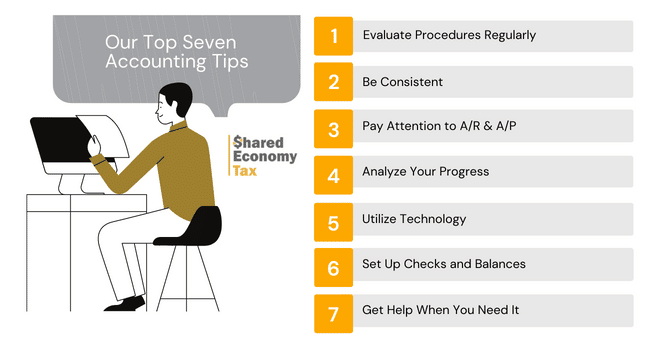Businesses of all sizes need reliable accounting and bookkeeping systems to track their finances, including corporations. Whether it’s a Wall Street PubCo or a small C-Corp, every corporate business’s accounting practices must comply with regulations. However, corporate accounting doesn’t have to be complicated. Your corporate accounting system is well on its way to success if you complete these seven simple steps.
The Best Corporate Accounting Tips
We’ve compiled a list of best practices that can help you streamline your accounting process and reduce errors along the way.
#1 Evaluate Corporate Accounting Procedures Regularly
It’s easy to get stuck in a rut. When procedures work well enough, your team members will continue to do the same process each month. Sometimes it takes bringing in fresh eyes or a discussion about what works (and what doesn’t) from the entire team’s perspective.
Change won’t happen automatically, so you should evaluate your procedures regularly, like every fiscal quarter.
You should also look for redundancies, so you can eliminate any unnecessary procedural tasks. It also pays to assess accounting processes from a top-to-bottom organizational perspective to ensure your team is on the same page.
#2 Be Consistent
Inconsistent accounting practices can lead to all kinds of problems, especially in corporations. You should put in place a system that works and document your policies, so your staff can reference them if needed.
For example, account receivable can be a headache for many companies. Many people avoid uncomfortable conversations about collecting money.
Set a firm invoice policy to eliminate any oversights and miscommunications. Inform your customers of all payment terms before you bill them, and list your payment policies on all invoices to ensure there’s no confusion.
You can also include late fees and other penalties to encourage timely payment, but, again, make sure you tell your clients about these policies in advance.
Set policies to ensure your staff addresses aging receivables appropriately. The longer
#3 Pay Attention to A/R & A/P
Most corporations utilize a double-entry accounting system, so accounting departments need to keep an eye on their receivable and payable account balances.
Someone should review accounts receivable at least once a month to ensure customers are getting paid on time. Slow payouts can make your vendors less eager to deal with you in the future. Pay outstanding invoices by the agreed upon due date at the latest to keep your suppliers and contractors happy.
Receivables are arguably even more important. Large A/R balances crunch your liquidity and cash flow, and they can become a serious problem if they’re allowed to grow unchecked. Furthermore, you are less likely to collect the debt if you let it grow too much, so you should address these issues as early as possible.
Update your customers on their outstanding balances by sending them statements regularly. These reports keep customers in the loop and increase the likelihood of on-time payment.
Posted any payments to accounts receivable as soon as possible. In some cases, this will mean daily updates, but smaller companies can often get by with weekly posting.
You should also post any payments made towards accounts payable when you write the check or make the electronic payment. This prevents duplicate payments and lets you see what cash you have available for other payments or owner distributions.
#4 Analyze Your Progress
You should review the profit and loss statement monthly. Depending on the size of your business, upper management may demand to see regular reporting and updates on the company’s financial situation. Smaller companies may not have the same rigid structure and reporting requirements.
Even if you work for a smaller company, it’s important to monitor the financial statements to identify any anomalies and spot new trends. A review of the financial statements should include an analysis of changes in overhead costs and costs of goods sold, along with a revenue review. Management should become aware of any significant changes.
Suppose you spot changes in the profit and loss. In that case, the management team should discuss ways to minimize any negative impact in the coming months. Changes may include seeking out new vendors with lower prices or renegotiating standing contracts with suppliers. In the event of shrinking sales, the company should evaluate its overhead expenses to find areas to cut back on costs.
#5 Utilize Corporate Accounting Technology
Bookkeeping used to involve a lot of manual data entry, but that is no longer the case. Bank statements can be downloaded and directly imported into accounting programs. Invoices can be scanned and processed by computers. You can store records safely and securely as PDFs. And you can send payments via ACH transfers or other electronic options.
There is very little reason to use manual processes in accounting.
To start automating many aspects of your accounting process, evaluate the areas where you spend most of your time. For example, if you have team members manually entering and verifying invoices, you may want to invest in software that can do the process for you.
Most companies accept electronic payments, so manual check writing and signing should be rare activities.
Going paperless can also help you identify areas of inefficiency. For example, there are very few modern accounting processes that need to involve physical paperwork. So if you find some paper-based processes in your accounting department, that is likely an area of potential improvement.
Once you’ve decided to automate your accounting tasks and go paperless, it’s vital to set up a system for storing your digital files, so they are easy to locate and identify. Make sure you train your team on the new system so that everyone is consistent with your procedures.
Digitizing your processes can also minimize the time lost handling data entry errors. Digital processes increase efficiency and can save you money on staffing costs.
#6 Set Up Checks and Balances
You should set up your accounting system to include checks and balances to reduce mistakes, prevent improper behavior such as employee fraud, and avoid centralizing too much power within the company.
There are several ways you can achieve a system to minimize the potential for fraud and errors.
Divide up responsibilities: The person who deposits money shouldn’t be in charge of recording deposits. Likewise, the person who enters the vendor invoices should not be the one who is responsible for signing the checks.
Restrict access to cash: Only allow access to petty cash and company credit cards to employees who need them. This may be difficult since some companies (such as restaurants) still heavily base their business on cash, but minimizing the number of people who can access cash will reduce the potential for loss. In addition, you should regularly review the receipts for petty cash and evaluate who has access to it.
#7 Get Help When You Need It with Corporate Accounting
Corporations often have complicated finances and a large number of financial transactions. The accounting department or outside consultant should be ready and willing to contact experts such as CPAs and lawyers when necessary. Recognizing your knowledge’s limits and seeking answers can avoid errors in your corporate accounting.
Don’t be afraid to pick up the phone and call an expert when you run into something that’s out of your league.
Need help streamlining your corporate accounting? Our tax experts can help you sort out complicated procedures or questions that might be beyond the scope of what your internal staff can handle. Contact us today to get a complimentary strategy session to see how we can help.

